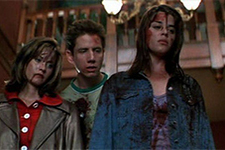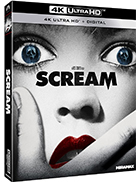Scream (1996) (4K UHD)
|  I grew up during the heyday of slasher movies. I was a year old when Bob Clark’s Black Christmas (1975) established the most basic tenets of the subgenre; I was four when John Carpenter’s masterful Halloween (1978) became a critical and commercial hit; my elementary and middle school years coincided with the rise of cable television, whose movie channels were stuffed at night with Friday the 13th and A Nightmare on Elm Street sequels and their many and undistinguished copycats; and I was in my late teens and early twenties when the subgenre was sputtering out (what we thought were) its last dying breaths with Freddy’s Dead: The Final Nightmare (1991), Jason Goes to Hell: The Final Friday (1993), and Halloween: The Curse of Michael Myers (1995). Thus, with its death rattles still audible, the slasher film was poised in the mid-1990s for resurrection … or reinvention … or reincarnation, which is precisely what Wes Craven’s Scream did. Craven, who wrote and directed A Nightmare on Elm Street (1984) along with a host of other influential horrors film in the 1970s and ’80s, was perfectly positioned to helm a new kind of smart, self-aware slasher film that could draw laughs from the audience who already knew the language and rules of the slasher film while still working in its own right. The tongue may have been firmly in the cheek, but Craven was more than willing to cut it off when necessary. Scream opens with a brilliantly realized sequence involving a teenage girl named Casey Becker (Drew Barrymore) getting a series of increasingly creepy and threatening phone calls while she is home alone. The fact that the entire sequence was clearly inspired by When a Stranger Calls (1979) and its visceral narrative impact owes more than a small debt to Hitchcock’s willingness to brutally kill off his film’s supposed star early on in Psycho (1960), quickly and efficiently makes clear that Scream is not striving for originality in content, but rather in its treatment of that content. By the mid-1990s, there wasn’t much that could be done with the slasher film that hadn’t been done already, which is why screenwriter Kevin Williamson chose to borrow from other, well-known slasher films and twist them to his own liking. This achieves two things: First, it allows him to parody and mock the ridiculousness of the genre (such as when a character is watching Halloween on television and is yelling at a victim to look behind her while he himself is being stalked from behind), and secondly, it allows him to generate real chills and some genuine scares by using what has worked before. The plot centers around a mysterious killer who is knocking off teenagers in a small, northern California town. This spate of knife-inflicted deaths may have something to do with the rape and murder one year earlier of the mother of high school senior Sidney Prescott (Neve Campbell, then best known for her role on the television series Party of Five). The list of possible suspects is long, ranging from her boyfriend, Billy Loomis (Johnny Depp look-alike Skeet Ulrich), to her own father (Lawrence Hecht). Thrown into the mix is a genial and awkward police deputy (David Arquette) and a local TV reporter (Courtney Cox) who doesn’t think the man Sidney fingered as her mother’s killer is really guilty and wrote a salacious book about it. Thus, the actual murderer could still be out there, waiting to strike again. Williamson’s screenplay lives and dies by the rules written years before by Bob Clark (Black Christmas), John Carpenter and Debra Hill (Halloween), Victor Miller (Friday the 13th), William Gray (Prom Night, 1980), Ruth Avergon (Night School, 1980), John Beaird (My Bloody Valentine, 1981), and others. However, what made Scream so unique and compelling at the time was that, rather than trying to obscure or distract from the imitation, Williamson and Craven revel in it, self-consciously putting the “rules” front and center, especially in a particularly knowing sequence where movie-obsessed geek named Randy (Jamie Kennedy) begins listing what not to do in a horror movie: don’t have sex, don’t drink or do drugs, and never say, “I’ll be right back,” because all of those things guarantee death. Viewers of the film already know that, but what was new at the time was watching characters who knew it, too. Nevertheless, most of the characters end up violating those very rules (while Randy is enumerating them, his friends are downing beers and heckling him). And, when they do, their actions invite a knowing smirk from us because everybody knows exactly what will happen. And, for the most part, Scream adheres closely to the tenets of the subgenre, although the revelation of the killer in the final 15 minutes throws just enough of a wrench in the works to qualify as an original twist on expectations, even if the whole sequence ultimately goes on a bit too long. While the slasher film has long been a critically derided subgenre, its enduring popularity attests to its status as a kind of modern folklore—the cinematic equivalent of gory campfire tales that play on our inherent fears of the dark and mysterious. In Scream, there is a careful balance between the known and the unknown, and it lures us so well with our supposed knowledge of what will and should happen that it creates some genuine surprises. Craven, who had already taken a postmodern hammer to his own Nightmare on Elm Street series with the clever and underrated meta-horror satire A New Nightmare (1994) two years earlier, deploys every tool in the proverbial toolbox to milk new life from the well-worn contours of the knife-wielding maniac story, and he is more than often successful. Unlike older slasher films that typically cast unknown performers (most of whom never generated much of a career, with Jamie Lee Curtis, Kevin Bacon, and Johnny Depp being the rare exceptions), Craven cast a range of well-known young actors who were on the rise and then mixed in amusing cameos by Linda “The Exorcist” Blair as a reporter and Henry “The Fonz” Winkler as the high school principal. However, as much as things change, some things stay the same, which included the MPAA coming down hard on the film’s grisly gore effects by Howard Berger, who had previously worked on Evil Dead II (1987), Creepshow 2 (1987), Misery (1990), and Reservoir Dogs (1992) (he would later go on to win an Oscar for 1995’s The Chronicles of Narnia: The Lion, the Witch and the Wardrobe). About 20 seconds of bloody footage had to be shaved from the theatrical release to secure an R-rating, thus aligning Scream with virtually every slasher film from the previous decade that had to jump through similar hoops. Released just before Christmas, Scream was a major hit theatrically, earning over $103 million at the domestic box office (placing it in the top 20 movies that year), which was unheard of for a slasher film. It was heavily cross-promoted on MTV (where it won the “Best Movie Award”) and became an icon of the new, slick, self-knowing postmodern horror trend, which led to a cycle of slasher film series, including I Know What You Did Last Summer, Urban Legend, and Final Destination, as well as remakes of virtually every slasher film from the 1970s and ’80s. It also spawned three sequels (1997, 2000, and 2011) and a forthcoming reboot, thus demonstrating that slasher films, like the relentless killers from which they derive their name, never really die.
Copyright © 2021 James Kendrick Thoughts? E-mail James Kendrick All images copyright © Paramount Home Entertainment | |||||||||||||||||||||||||||||
Overall Rating: 

 (3)
(3)


